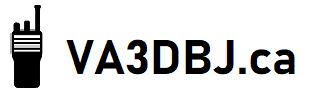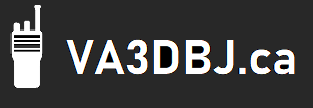The following are the different digital modes being used the the Durham Region area. Some of the repeaters are in multi-mode, where different modes are available in addition to regular FM voice.

DMR – Digital Mobile Radio
DMR, or Digital Mobile Radio, is explained in more detail, via my scanner DMR page, but a more simplistic explanation follows:
Tier I
DMR Tier I products are for license-free use in the 446 MHz band in the European Union.
This part of the standard provides for consumer applications and low-power commercial applications, using a maximum of 0.5 watt RF power. With a limited number of channels and no use of repeaters, no use of telephone interconnects, fixed/integrated antennas, and a talk timer of 180 seconds, Tier I DMR devices are best suited for personal use, recreation, small retail and other settings that do not require wide area coverage or advanced features.
Tier II
DMR Tier II covers licensed conventional radio systems, mobiles and hand portables operating in PMR frequency bands from 66-960MHz. The ETSI DMR Tier II standard is targeted at those users who need spectral efficiency, advanced voice features and integrated IP data services in licensed bands for high-power communications. ETSI DMR Tier II specifies two slot TDMA in 12.5 kHz channels.
DMR Tier II is based on the following ETSI standards.
- ETSI TS 102 361-1 Air interface
- ETSI TS 102 361-2 Voice and generic services and facilities
- ETSI TS 102 361-3 Data protocol
Tier III
DMR Tier III covers trunking operation in frequency bands 66-960MHz. The Tier III standard specifies two slot TDMA in 12.5kHz channels. Tier III supports voice and short messaging handling similar to MPT 1327 with built-in 128 character status messaging and short messaging with up to 288 bits of data in a variety of formats. It also supports packet data service in a variety of formats, including support for IPv4 and IPv6.
Talk Groups
Talk Groups (TG) are a way for groups of users to share a time slot, without distracting and disrupting other users of the time slot. It should be noted that only one Talk Group can be using a time slot at a time. If your radio is not programmed to listen to a Talk Group, you will not hear that Talk Group’s traffic.
The DMR-MARC Mototrbo™ network supports a number of Talk Groups on TS1 including World Wide (TG1, PTT), North America (TG3), and World Wide English (TG13). TS2 is for local, state, and regional Talk Groups. The DCI/TRBO network uses TG3163 for North America and TG3161 for World Wide, and TG3 for World Wide English on TS2.
The DMR standard also supports private calls (one-to-one), encryption, and data. Private calls are not allowed by most of the amateur networks and many consider private calls not amateur friendly; private calls tie up a large number of repeater time slots across the network. Encryption is not legal on amateur radio in the USA but is allowed in Canada! Data and text messaging is supported on some networks.
For simplex traffic, the accepted standard in the amateur community is to use TG99 on TS1 with CC1.
DMR Repeaters
The following DMR repeaters are available in the Durham Region area:
BrandMeister Network
VE3OBI – Courtice – 442.1375 – CC1
VE3SBX – Ajax – 442.3625 – CC3
VE3LBN – Oshawa – 443.9875 – CC3
VA3WIK – Toronto – 442.1875 – CC4
VE3NUS – Toronto – 444.2875 – CC1
TalkGroups
9 = Local/Region
91 = Worldwide
93 = North America
99 = Simplex
302 = Canada
310 = TAC-310
311 = TAC-311
3023 = Ontario
DMR-MARC Network
VA3XPR – Toronto – 442.3375 – CC1 (Disabled due to jamming)
The following are the different digital modes being used the the Durham Region area. Some of the repeaters are in multi-mode, where different modes are available in addition to regular FM voice.

DMR – Digital Mobile Radio
DMR, or Digital Mobile Radio, is explained in more detail, via my scanner DMR page, but a more simplistic explanation follows:
Tier I
DMR Tier I products are for license-free use in the 446 MHz band in the European Union.
This part of the standard provides for consumer applications and low-power commercial applications, using a maximum of 0.5 watt RF power. With a limited number of channels and no use of repeaters, no use of telephone interconnects, fixed/integrated antennas, and a talk timer of 180 seconds, Tier I DMR devices are best suited for personal use, recreation, small retail and other settings that do not require wide area coverage or advanced features.
Tier II
DMR Tier II covers licensed conventional radio systems, mobiles and hand portables operating in PMR frequency bands from 66-960MHz. The ETSI DMR Tier II standard is targeted at those users who need spectral efficiency, advanced voice features and integrated IP data services in licensed bands for high-power communications. ETSI DMR Tier II specifies two slot TDMA in 12.5 kHz channels.
DMR Tier II is based on the following ETSI standards.
- ETSI TS 102 361-1 Air interface
- ETSI TS 102 361-2 Voice and generic services and facilities
- ETSI TS 102 361-3 Data protocol
Tier III
DMR Tier III covers trunking operation in frequency bands 66-960MHz. The Tier III standard specifies two slot TDMA in 12.5kHz channels. Tier III supports voice and short messaging handling similar to MPT 1327 with built-in 128 character status messaging and short messaging with up to 288 bits of data in a variety of formats. It also supports packet data service in a variety of formats, including support for IPv4 and IPv6.
Talk Groups
Talk Groups (TG) are a way for groups of users to share a time slot, without distracting and disrupting other users of the time slot. It should be noted that only one Talk Group can be using a time slot at a time. If your radio is not programmed to listen to a Talk Group, you will not hear that Talk Group’s traffic.
The DMR-MARC Mototrbo™ network supports a number of Talk Groups on TS1 including World Wide (TG1, PTT), North America (TG3), and World Wide English (TG13). TS2 is for local, state, and regional Talk Groups. The DCI/TRBO network uses TG3163 for North America and TG3161 for World Wide, and TG3 for World Wide English on TS2.
The DMR standard also supports private calls (one-to-one), encryption, and data. Private calls are not allowed by most of the amateur networks and many consider private calls not amateur friendly; private calls tie up a large number of repeater time slots across the network. Encryption is not legal on amateur radio in the USA but is allowed in Canada! Data and text messaging is supported on some networks.
For simplex traffic, the accepted standard in the amateur community is to use TG99 on TS1 with CC1.
DMR Repeaters
The following DMR repeaters are available in the Durham Region area:
BrandMeister Network
VE3OBI – Courtice – 442.1375 – CC1
VE3SBX – Ajax – 442.3625 – CC3
VE3LBN – Oshawa – 443.9875 – CC3
VA3WIK – Toronto – 442.1875 – CC4
VE3NUS – Toronto – 444.2875 – CC1
TalkGroups
9 = Local/Region
91 = Worldwide
93 = North America
99 = Simplex
302 = Canada
310 = TAC-310
311 = TAC-311
3023 = Ontario
DMR-MARC Network
VA3XPR – Toronto – 442.3375 – CC1 (Disabled due to jamming)
TalkGroups
1 = World Wide
2 = Local 1
3 = North America
8 = Golden Horseshoe Area
9 = Local 2
13 = WW English
113 = UAE 1
123 = UAE 2
302 = Canada
310 = TAC310
3023 = Ontario
3022 = Quebec
3024 = Manitoba
3026 = Alberta
3029 = New Brunswick
3027 = British Columbia
9998 = Parrot
9999 = Audio Test
Presently, all Toronto area DMR-MARC repeaters have been disabled due to jamming/interference.
NXDN – Next Generation Digital Narrowband
The NXDN (Next Generation Digital Narrowband) common air interface protocol, which was developed jointly by ICOM and Kenwood, uses Frequency Division Multiple Access (FDMA), employing a 4-level FSK modulation scheme. These companies and others together form the NXDN Forum.
Kenwood’s brand for NXDN equipment is “NEXEDGE”, while Icom’s brand for NXDN equipment is “IDAS”, or Icom Digital Advanced System. For a more detailed information via my scanner NXDN page.
NXDN Repeaters
The following NXDN repeaters are available in the Durham Region area:
TalkGroups
1 = World Wide
2 = Local 1
3 = North America
8 = Golden Horseshoe Area
9 = Local 2
13 = WW English
113 = UAE 1
123 = UAE 2
302 = Canada
310 = TAC310
3023 = Ontario
3022 = Quebec
3024 = Manitoba
3026 = Alberta
3029 = New Brunswick
3027 = British Columbia
9998 = Parrot
9999 = Audio Test
Presently, all Toronto area DMR-MARC repeaters have been disabled due to jamming/interference.
NXDN – Next Generation Digital Narrowband
The NXDN (Next Generation Digital Narrowband) common air interface protocol, which was developed jointly by ICOM and Kenwood, uses Frequency Division Multiple Access (FDMA), employing a 4-level FSK modulation scheme. These companies and others together form the NXDN Forum.
Kenwood’s brand for NXDN equipment is “NEXEDGE”, while Icom’s brand for NXDN equipment is “IDAS”, or Icom Digital Advanced System. For a more detailed information via my scanner NXDN page.
NXDN Repeaters
The following NXDN repeaters are available in the Durham Region area:
Work in progress..










